Closed Chamber Test Analysis
Subtopics:
A closed chamber test is a Perforation Inflow Test with a step-reduction in the wellbore volume at some point during the test. It is essentially equivalent to a drillstem test (DST) that is conducted with the wellhead valve closed, so that all formation fluid is accumulated in the wellbore and is not produced at surface. The figure below illustrates a typical wellbore configuration used to conduct a closed chamber test.
Figure 1: CCT Wellbore Configuration
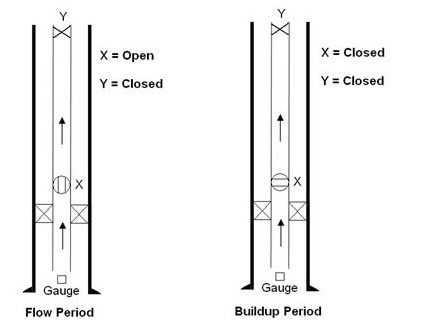
| Note: | For additional information, see Closed Chamber Inflow Test Type. |
Theory
Just like in PITA, closed chamber test analysis is based on the principles of slug tests, and incorporates procedures for both liquid and gas flow, using the concept of a stepped change in wellbore storage. Early time data (during the flow period) is used to estimate skin (s'), and late time data (during the buildup period) is used to estimate initial reservoir pressure (pi) and permeability (k), similar to PITA. Pressures are measured downhole, below the shut-in device (see Figure 1).
The influx flow rate is not measured, but can be estimated using closed chamber calculations, provided the assumption of single-phase flow can be justified. Figure 2 shows the typical profiles of measured pressure and the calculated gas influx rate for a closed chamber test performed on a gas zone. As shown here, the pressure increases slowly during the flow period due to a large wellbore volume (Vw). After the downhole valve is closed (or a plug is set), and the wellbore volume (Vw) is reduced, the pressure increases much faster. At the same time, the calculated influx rate drops due to the reduced wellbore volume (Vw).
Figure 2: CCT Pressure and Gas Influx Rate Profile
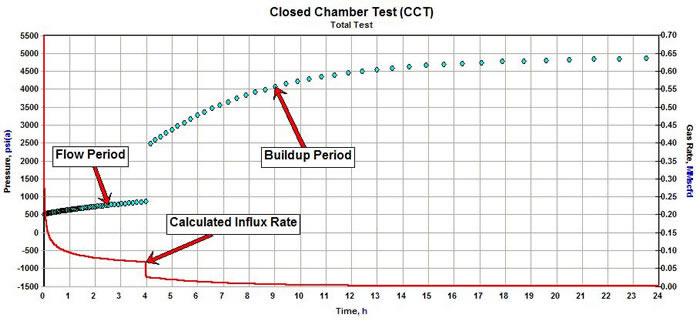
Flow Regimes
Just like in PITA, the critical part of the analysis is distinguishing between the data that is dominated by wellbore storage (afterflow), and the data that is dominated by the reservoir response (radial flow). This is accomplished by constructing a derivative plot similar to that used for PITA. If downhole shut-in is achieved early in the test (during the wellbore storage period), the CCT derivative will exhibit an immediate decrease in wellbore storage, and a quick transition to reservoir (radial) flow follows, as shown in below.
Figure 3: CCT Pressure Derivative
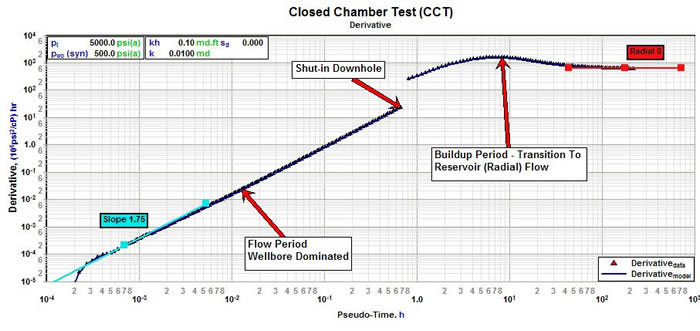
Analysis
The late and early time analyses are performed in the same manner as for PITA, but the late time equation is modified to consider the stepped change in wellbore volume (Vw)
Figure 4 shows the late time analysis plot used to calculate initial reservoir pressure (pi) and permeability (k) for a gas zone. After estimates of initial reservoir pressure (pi) and permeability (k) are obtained, an early time analysis is performed to calculate skin (s'), as depicted in Figure 5.
Figure 4: CCT Late Time Analysis
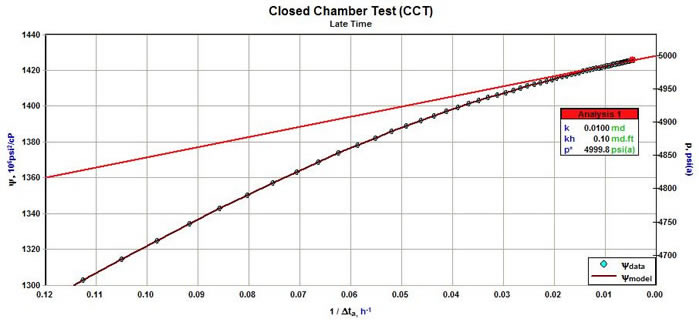
Figure 5: CCT Early Time Analysis
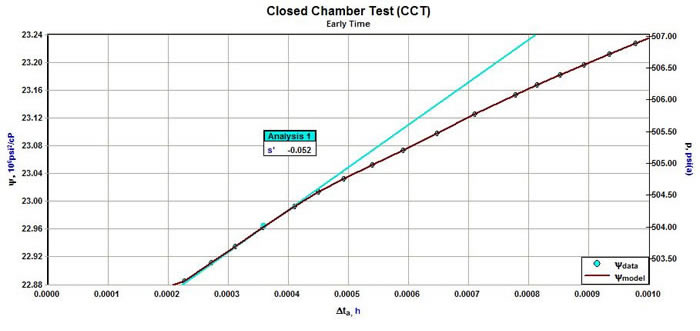
| Note: | The skin (s') calculations are performed using the same equations developed for PITA. |
After the key reservoir parameters (initial reservoir pressure (pi), permeability (k), and skin (s')) are estimated from the CCT analysis, a CCT model is performed to confirm the estimated parameters. This is especially critical when reservoir-dominated (radial) flow is not achieved within a test period, or when data-scatter aggravates the analysis.
References
"A New Approach for Interpreting Pressure Data to Estimate Key Reservoir Parameters from Closed-Chamber Tests", N.M.A. Rahman, SPE, Schlumberger; M.S. Santo and L. Mattar, SPE, Fekete Associates Inc., Paper SPE 109860 presented at the 2007 SPE ATCE held in Anaheim, California, U.S.A., 11 - 14, November.